Here is a simple and visual way to validate that two of your fonts produce the same characters.
Define a ConstraintLayout with four TextViews: tv1, tv2,
tv3 and tv4. Define the text colors and fonts as follows. You
are checking font1 and font2 against each other. (Make sure that the background of the TextViews is transparent.
tv1: red, font1 tv2: blue, font2 tv3: blue, font2 tv4: red, font1
Place tv1 on top of tv2 and tv3 on tv4.
Place all the characters you want to check into each of the TextViews. Look for any color that doesn't match the color of the
top TextView. For tv1 on top of tv2 your should see all red
and no blue. For tv3 on top of tv4 your should see all blue and
no red.
This could be automated but may not be worth the effort if a simple setup and visual inspection will suffice. One worthwhile automation may be to look for pixels of an offending color.
Here is what the layout could be. This trivial case just looks at the default font as bold and not bold.
<androidx.constraintlayout.widget.ConstraintLayout
android:layout_width="match_parent"
android:layout_height="match_parent"
android:layout_margin="16dp"
tools:context=".MainActivity">
<TextView
android:id="@+id/tv2"
android:layout_width="0dp"
android:layout_height="wrap_content"
android:background="@android:color/transparent"
android:text="ABCEFGHIJKLMNOPQRSTUVWXYZ"
android:textColor="@android:color/holo_blue_light"
android:textSize="20sp"
android:visibility="visible"
app:layout_constraintEnd_toEndOf="parent"
app:layout_constraintStart_toStartOf="parent"
app:layout_constraintTop_toTopOf="parent" />
<TextView
android:id="@+id/tv1"
android:layout_width="0dp"
android:layout_height="wrap_content"
android:background="@android:color/transparent"
android:text="ABCEFGHIJKLMNOPQRSTUVWXYZ"
android:textColor="@android:color/holo_red_light"
android:textSize="20sp"
android:textStyle="bold"
android:visibility="visible"
app:layout_constraintEnd_toEndOf="parent"
app:layout_constraintStart_toStartOf="parent"
app:layout_constraintTop_toTopOf="parent" />
<TextView
android:id="@+id/tv3"
android:layout_width="0dp"
android:layout_height="wrap_content"
android:background="@android:color/transparent"
android:text="ABCEFGHIJKLMNOPQRSTUVWXYZ"
android:textColor="@android:color/holo_red_light"
android:textSize="20sp"
android:textStyle="bold"
android:visibility="visible"
app:layout_constraintEnd_toEndOf="parent"
app:layout_constraintStart_toStartOf="parent"
app:layout_constraintTop_toBottomOf="@id/guideline" />
<TextView
android:id="@+id/tv4"
android:layout_width="0dp"
android:layout_height="wrap_content"
android:background="@android:color/transparent"
android:text="ABCEFGHIJKLMNOPQRSTUVWXYZ"
android:textColor="@android:color/holo_blue_light"
android:textSize="20sp"
android:visibility="visible"
app:layout_constraintEnd_toEndOf="parent"
app:layout_constraintStart_toStartOf="parent"
app:layout_constraintTop_toBottomOf="@id/guideline" />
<androidx.constraintlayout.widget.Guideline
android:id="@+id/guideline"
android:layout_width="wrap_content"
android:layout_height="wrap_content"
android:orientation="horizontal"
app:layout_constraintGuide_percent="0.50" />
</androidx.constraintlayout.widget.ConstraintLayout>
Here is the output to see the differences. This snapshot is from the Android Studio designer.

If there are potentially a lot of characters to check, the above method will be difficult and prone to error. A more automated way is to define two text views like above, load them with identical text but use two fonts that will be tested against each other.
MainActivity.java
Here is a short bit of code that takes two TextViews and compares them pixel-by-pixel and logs if they are different or the same.
public class MainActivity extends AppCompatActivity {
@Override
protected void onCreate(Bundle savedInstanceState) {
super.onCreate(savedInstanceState);
setContentView(R.layout.activity_main);
final TextView tv1, tv2;
tv1 = findViewById(R.id.tv1);
tv2 = findViewById(R.id.tv2);
// Get all characters to check into a string.
String s = getTextToCheck();
tv1.setText(s);
tv2.setText(s);
final ConstraintLayout mLayout = findViewById(R.id.layout);
mLayout.post(new Runnable() {
@Override
public void run() {
Bitmap bitmap = Bitmap.createBitmap(mLayout.getWidth(), mLayout.getHeight(),
Bitmap.Config.ARGB_8888);
Canvas canvas = new Canvas(bitmap);
mLayout.draw(canvas);
compareRects(bitmap, getViewRect(tv1), getViewRect(tv2));
}
});
}
private void compareRects(Bitmap bitmap, Rect rect1, Rect rect2) {
int x1 = rect1.left;
int x2 = rect2.left;
if (rect1.width() != rect2.width()) {
Log.i("CompareFonts", "<<<< TextView widths do not match");
}
if (rect1.height() != rect2.height()) {
Log.i("CompareFonts", "<<<< TextView heights do not match");
}
int totalPixels = 0;
int diffCount = 0;
while (x1 < rect1.right && x2 < rect2.right) {
int y1 = rect1.top;
int y2 = rect2.top;
while (y1 < rect1.bottom && y2 < rect2.bottom) {
int pixel1 = bitmap.getPixel(x1, y1);
int pixel2 = bitmap.getPixel(x2, y2);
if (pixel1 != pixel2) {
diffCount++;
totalPixels++;
} else if (pixel1 != 0) {
totalPixels++;
}
y1++;
y2++;
}
x1++;
x2++;
}
Log.i("CompareFonts", String.format(Locale.US, "<<<< Total pixels compared = %,d", totalPixels));
Log.i("CompareFonts", String.format(Locale.US, "<<<< Different pixel count = %,d (%%%.2f) ",
diffCount, (float) diffCount * 100 / totalPixels));
}
private Rect getViewRect(View view) {
Rect rect = new Rect();
rect.left = view.getLeft() + view.getPaddingLeft();
rect.right = view.getRight() - view.getPaddingRight();
rect.top = view.getTop() + view.getPaddingTop();
rect.bottom = view.getBottom() - view.getPaddingBottom();
return rect;
}
private String getTextToCheck() {
// Define any text to check. This is just the printable ASCII character set.
StringBuilder sb = new StringBuilder();
for (int i = 32; i <= 126; i++) {
sb.append((char) i);
}
return sb.toString();
}
}


